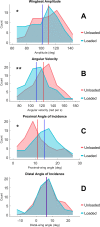Zebra finch (Taeniopygia guttata) shift toward aerodynamically efficient flight kinematics in response to an artificial load
- PMID: 31142468
- PMCID: PMC6602328
- DOI: 10.1242/bio.042572
Zebra finch (Taeniopygia guttata) shift toward aerodynamically efficient flight kinematics in response to an artificial load
Abstract
We investigated the effect of an added mass emulating a transmitter on the flight kinematics of zebra finches (Taeniopygia guttata), both to identify proximal effects of loading and to test fundamental questions regarding the intermittent flight of this species. Zebra finch, along with many species of relatively small birds, exhibit flap-bounding, wherein the bird alternates periods of flapping with flexed-wing bounds. Mathematical modeling suggests that flap-bounding is less aerodynamically efficient than continuous flapping, except in limited circumstances. This has prompted the introduction of two major hypotheses for flap-bounding - the 'fixed-gear' and 'cost of muscle activation/deactivation' hypotheses - based on intrinsic properties of muscle. We equipped zebra finches flying at 10 m s-1 with a transmitter-like load to determine if their response was consistent with the predictions of these hypotheses. Loading caused finches to diverge significantly from their unloaded wingbeat kinematics. Researchers should carefully consider whether these effects impact traits of interest when planning telemetry studies to ensure that tagged individuals can reasonably be considered representative of the overall population. In response to loading, average wingbeat amplitude and angular velocity decreased, inconsistent with the predictions of the fixed-gear hypothesis. If we assume that finches maintained muscular efficiency, the reduction in amplitude is inconsistent with the cost of the muscle activation/deactivation hypothesis. However, we interpret the reduction in wingbeat amplitude and increase in the proportion of time spent flapping as evidence that loaded finches opted to increase their aerodynamic efficiency - a response which is consistent with the latter hypothesis.
Keywords: Flap-bounding; Intermittent flight; Kinematics; Zebra finch.
© 2019. Published by The Company of Biologists Ltd.
Conflict of interest statement
Competing interestsThe authors declare no competing or financial interests.
Figures


References
-
- Aldridge H. D. (1986). Kinematics and aerodynamics of the greater horseshoe bat, Rhinolophus ferrumequinum, in horizontal flight at various flight speeds. J. Exp. Biol. 126, 479-497. - PubMed
-
- Aldridge H. D. J. N. and Brigham R. M. (1988). Load carrying and maneuverability in an insectivorous bat: a test of the 5% “rule” of radio-telemetry. J. Mammology 69, 379-382. 10.2307/1381393 - DOI
-
- Askew G. N., Marsh R. L. and Ellington C. P. (2001). The mechanical power output of the flight muscles of blue-breasted quail (Coturnix chinensis) during take-off. J. Exp. Biol. 204, 3601-3619. - PubMed
LinkOut - more resources
Full Text Sources

